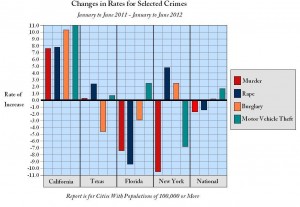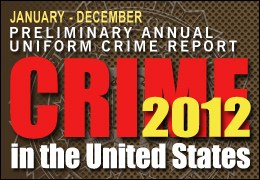By Michael Rushford
 With the recent FBI release of preliminary crime statistics for the first six months of 2012, and continuing reports on local crime from news organizations and police agencies across the state, it is becoming increasingly clear that something happened in California last year that caused a sharp increase in virtually every major category of crime.┬Ā The FBI report found a small increase nationally in violent and property crime driven by larger increases in the West.┬Ā Since the sweeping changes in sentencing under Governor Jerry BrownŌĆÖs Public Safety Realignment law took effect in October 2011, the California-based Criminal Justice Legal Foundation has been monitoring criminal activity across the state to gauge the lawŌĆÖs effect on public safety.
With the recent FBI release of preliminary crime statistics for the first six months of 2012, and continuing reports on local crime from news organizations and police agencies across the state, it is becoming increasingly clear that something happened in California last year that caused a sharp increase in virtually every major category of crime.┬Ā The FBI report found a small increase nationally in violent and property crime driven by larger increases in the West.┬Ā Since the sweeping changes in sentencing under Governor Jerry BrownŌĆÖs Public Safety Realignment law took effect in October 2011, the California-based Criminal Justice Legal Foundation has been monitoring criminal activity across the state to gauge the lawŌĆÖs effect on public safety.
While the reports we have collected from local law enforcement agencies over the past year and the recent preliminary report from the FBI are not proof of a trend, they do show a large and abrupt, across-the-board increase in California crime rates which is disturbing.
The Criminal Justice League Foundation noted that, in a January 28, 2013 report, researchers at the University of Minnesota identified a downward national trend in crime, citing better technology and changing social dynamics.┬Ā In December, New York Mayor Michael Bloomberg boasted that his cityŌĆÖs declining incarceration rate and improved policing had caused a dramatic decrease in major felonies.
The recent FBI report tells a different story.┬Ā Over the first six months of 2012, violent crime in New York City increased by 3.9% and property crime climbed 6.1%.┬Ā But not all large states saw increases, Florida and Texas, both of which have reduced some incarceration rates but maintain tough-on-crime sentencing policies, saw only slight increases or declining rates.┬Ā States which have been more aggressive at reducing the incarceration of felons, particularly along the West Coast have reversed the trend of reduced crime in recent years and saw rising rates of both violent and property crimes.
CaliforniaŌĆÖs increase has been the most dramatic.┬Ā The FBI report for 2011 had crime dropping in all categories compared to the previous year.┬Ā The preliminary report for 2012 shows significant increases.┬Ā In a February 3, 2013 Pasadena Star-News story, the Police Chiefs of Pasadena, Glendale, and Covina expressed their concerns about rising crime caused by Realignment.┬Ā ŌĆ£This is a dangerous public policy,ŌĆØ Glendale Police Chief Brian De Pompa told reporters.┬Ā ŌĆ£Without strong state prison accountability, itŌĆÖs hard to control crime.ŌĆØ
San Francisco District Attorney George Gascon disagrees.┬Ā His city has embraced the evidence-based rehabilitation and probation approach to most felons, an approach praised by the ACLU.┬Ā In a January 19, 2013 Los Angeles Daily News story, Gascon said, ŌĆ£I know that we cannot incarcerate our way out of this problem.ŌĆØ┬Ā Unfortunately, according to a January Associated Press story, the homicide rate in San Francisco increased by 36% last year, and the trend is continuing.┬Ā On January 1, 2013, documented gang member David Morales, 19, allegedly killed two people while being pursued by police in San Francisco.┬Ā Morales is suspected of having driven through a housing complex and shooting at three men.┬Ā Police matched the description of the vehicle involved in the shooting to MoralesŌĆÖs car.┬Ā Officers then tried to pull him over.┬Ā In the ensuing high-speed chase, Morales rammed into a car at an intersection and sent it spinning into a pedestrian.┬Ā Both the passenger of the car, 29-year-old Silvia Tuncun, and the pedestrian, 26-year-old Francisco Gutierrez, were killed.┬Ā MoralesŌĆÖs most recent conviction was in April 2012 for gang activity which, under Realignment, left him free on probation at the time of the killings.
Something happened in California last year that has caused a major shift in crime rates. Excuses by supporters of the GovernorŌĆÖs Realignment are of little comfort to Californians who have lost friends or loved ones to so-called ŌĆślow-levelŌĆÖ felons left in our communities because of this dangerous law.



